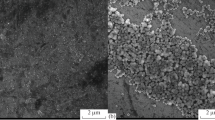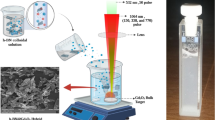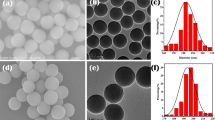Abstract
In this study, BT@ZnO:Yb heterostructures prepared using the combined sol-gel-hydrothermal methods were coated with chitosan (Qo) to obtain a hybrid heterostructure [BT@ZnO:Yb]-Qo. The structure, particle morphology, luminescence properties, and cytotoxicity of the hybrid heterostructure are discussed. X-ray diffraction (XRD), scanning electron microscopy (SEM), transmission electron microscopy (TEM), Fourier transform infra-red (FT-IR) as well as Raman and photoluminescence spectra, were used for characterisation and monitoring of the heterostructure formation process. The results reveal the formation of the BT@ZnO:Yb heterostructure, and are consistent with the relative intensities and positions of peaks in the XRD spectra of BT and ZnO:Yb, with the average particle size of ~75 nm. Effective Qo coating was achieved and a narrow, well-defined, and high-intensity luminescence signal was detected at ~610 nm for all the analysed samples. In vitro studies suggested that treatment with 1 µg/ml BT@ZnO:Yb 3 mol% induced very low cytotoxicity on HeLa cells.

The morphologie of the [BT@ZnO:Yb]-Qo heterostructures shows that the Nps were uniformly distributed throughout the Qo matrix, with the average particle diameter of ~80 nm with the tennis-ball-like spheres after the incorporation of chitosan. The prepared hybrid heterostructures exhibited a narrow, well-defined, and high-intensity luminescence peak at ~610 nm for all the analysed samples, and low cytotoxicity at 1 μg/ml.
Highlights
-
BaTiO3@ZnO:Yb heterostructures can be obtained by the sol-gel-hydrothermal process.
-
Effective heterostructures based on the coating with Qo, [BT@ZnO:Yb]-Qo, were synthesised with low cytotoxicity.
-
The PL intensity depends on the pH of the dispersion medium.
-
Ytterbium luminescence can be used in diagnostic imaging.






Similar content being viewed by others
References
Tonga GY, Moyano DF, Kim CS, Vincent M (2014) Inorganic nanoparticles for therapeutic delivery: Trials, tribulations and promise. Curr Opin Colloid Interface Sci 19:49–55
Krishna KS, Li Y, Li S, Kuma SSR (2013) Lab-on-a-chip synthesis of inorganic nanomaterials and quantum dots for biomedical applications. Adv Drug Deliv Rev 65:1470–1495
Gamelin DR (2001) Upconversion processes in transition metal and rare earth metal systems. In: Y. H (ed.) Transition metal and rare earth compounds. Springer, Germany, pp 1–56
Boyde R (2003) Nonlinear optics, 2nd edn. Academic Press, NY, USA
Hasan SB, Lederer F, Rockstuhl C (2014) Nonlinear plasmonic antennas. Mater Today 17:478–485
Baumner R, Bonacina L, Enderlein J, Extermann J, Fricke-Begemann T, Marowsky G, Wolf JP (2010) Evanescent-field-induced second harmonic generation by noncentrosymmetric nanoparticles. Opt Express 18:23218–23225
Chen WL, Hu PS, Ghazaryan A, Chen SJ, Tsai TH, Dong CY (2012) Quantitative analysis of multiphoton excitation autofluorescence and second harmonic generation imaging for medical diagnosis. Comput Med Imaging Graph 36:519–526
Chin H-A, Mao S, Meng F, Ohemeng KK, Purohit PK, Wagner S, McAlpine MC (2016) A flexible barium strontium titanate photodetector array. Extrem Mech Lett 8:47–54
Staedler D, Magouroux T, Hadji R, Joulaud C, Extermann J, Schwung S, Passemard S, Kasparian C, Clarke G, Gerrmann M, Le Dantec R, Mugnier Y, Rytz D, Ciepielewski D, Galez C, Gerber-Lemaire S, Juillerat-Jeanneret L, Bonacina L, Wolf JP (2012) Harmonic nanocrystals for biolabeling: a survey of optical properties and biocompatibility. ACS Nano 6:2542–2549
Gu B, Pliss A, Kuzmin AN, Baev A, Ohulchanskyy TY, Damasco JA, Yong KT, Wen S, Prasad PN (2016) In-situ second harmonic generation by cancer cell targeting ZnO nanocrystals to effect photodynamic action in subcellular space. Biomaterials 104:78–86
Dong N, Yao Y, Jia Y, Chen F, Vanga SK, Bettiol AA, Lu Q (2012) Buried channel waveguides in KTiOPO4 nonlinear crystal fabricated by focused He+ beam writing. Opt Mater 35:184–186
Fontana MD, Abarkan M, Salvestrini JP (2014) Calculation of the dispersion of the electro-optical and second harmonic coefficients from the refractive index dispersion. Opt Mater 36:764–768
Ladj R, Magouroux T, Eissa M, Dubled M, Mugnier Y, Dantec RL, Galez C, Valour J-P, Fessi H, Elaissari A (2013) Aminodextran-coated potassium niobate (KNbO3) nanocrystals for second harmonic bio-imaging. Colloid Surf A 439:131–137
Wang Y, Chen Z, Ye Z, Huang JY (2012) Synthesis and second harmonic generation response of KNbO3 nanoneedles. J Cryst Growth 341:42–45
Shi X, Ma Z, He C, Wu K (2014) Strong SHG responses predicted in binary metal halide crystal HgI2. Chem Phys Lett 608:219–223
Yadav TK, Singh AK, Kumar K, Yadav RA (2011) Luminescence and second harmonic generation in Eu3+/Eu2+ embedded B2O3:LiNbO3 non-linear glass–ceramics. Opt Mater 33:1732–1736
Shohanya BG, Zak AK (2020) Doped ZnO nanostructures with selected elements-structural, morphology and optical properties: a review. Ceram Int 46:5507–5520
Mirzaei H, Darroudi M (2017) Zinc oxide nanoparticles: Biological synthesis and biomedical applications. Ceram Int 43:907–914
Özgür Ü, Alivov YI, Liu C, Teke A, Reshchikov MA, Doğan S, Avrutin V, Cho SJ, Morkoç H (2005) A comprehensive review of ZnO materials and devices. J Appl Phys 98:041301
Giner-Casares JJ, Henriksen-Lacey M, Coronado-Puchau M, Liz-Marzán LM (2016) Inorganic nanoparticles for biomedicine: where materials scientists meet medical research. Mater Today 19:19–28
Hernandez ME, Rembao JD, Hernandez-Baltazar D, Castillo-Rodriguez RA, Tellez-Lopez VM, Flores-Martinez YM, Orozco-Barrios CE, Rubio HA, Sanchez-Garcia A, Ayala-Davila J, Arango-Rodriguez ML, Pavon L, Mejia-Castillo T, Forgez P, Martinez-Fong D (2014) Safety of the intravenous administration of neurotensin-polyplex nanoparticles in BALB/c mice. Nanomed-Nanotecnol 10:745–754
Archana D, Singh BK, Dutta J, Dutta PK (2015) Chitosan-PVP-nano silver oxide wound dressing: in vitro and in vivo evaluation. Int J Biol Macromol 73:49–57
Meshram JV, Koli VB, Phadatare MR, Pawar SH (2017) Anti-microbial surfaces: An approach for deposition of ZnO nanoparticles on PVA-Gelatin composite film by screen printing technique. Mater Sci Eng C Mater Biol Appl 73:257–266
Wang X, Chang J, Wu C (2018) Bioactive inorganic/organic nanocomposites for wound healing. Appl Mat Today 11:308–319
Kong M, Chen XG, Xing K, Park HJ (2010) Antimicrobial properties of chitosan and mode of action: a state of the art review. Int J Food Microbiol 144:51–63
Bernkop-Schnurch A, Dunnhaupt S (2012) Chitosan-based drug delivery systems. Eur J Pharm Biopharm 81:463–469
Barria I, Guiza J, Cifuentes F, Zamorano P, Saez JC, Gonzalez J, Vega JL (2018) Trypanosoma cruzi Infection Induces Pannexin-1 Channel Opening in Cardiac Myocytes. Am J Trop Med Hyg 98:105–112
McMurdie H, Morris M, Evans E, Paretzkin B, Wong-Ng W, Hubbard C (1986) Standard X-Ray Diffraction Powder Patterns from The JCPDS Research Associateship. Powder Diffr 1:265–275
Fuentes S, Zárate RA, Chávez E, Muñoz P, Ayala M, Espinoza-González R, Leyton P (2010) Synthesis and characterization of BaTiO3 nanoparticles in oxygen atmosphere. J Alloy Compd 505:568–572
Goel S, Kumar B (2020) A review on piezo-/ferro-electric properties of morphologically diverse ZnO nanostructures. J Alloy Compd 816:152491–152523
Zhang J, Du J, Han B, Liu Z, Jiang T, Zhang Z (2006) Sonochemical formation of single-crystalline gold nanobelts. Angew Chem 118:1134–1137
Saeed Sel S, El-Moll MM, Hassan ML, Bakir E, Abdel-Mottaleb MM, Abdel-Mottaleb MS (2014) Novel chitosan-ZnO based nanocomposites as luminescent tags for cellulosic materials. Carbohydr Polym 99:817–824
Magesh G, Bhoopathi G, Nithya N, Arun AP, Ranjith Kumar E (2018) Tuning effect of polysaccharide Chitosan on structural, morphological, optical and photoluminescence properties of ZnO nanoparticles. Superlattices Microstruct 117:36–45
Toiserkani H (2015) Fabrication and characterization chitosan/functionalized zinc oxide bionanocomposites and study of their antibacterial activity. Compos Interfaces 23:175–189
Damen TC, Porto SPS, Tell B (1966) Raman Effect in Zinc Oxide. Phys Rev 142:570–574
Jaramillo AF, Baez-Cruz R, Montoya LF, Medinam C, Pérez-Tijerina E, Salazar F, Rojas D, Melendrez MF (2017) Estimation of the surface interaction mechanism of ZnO nanoparticles modified with organosilane groups by Raman Spectroscopy. Ceram Int 43:11838–11847
Zolfaghari M (2019) Propose for Raman mode position for Mn-doped ZnO nanoparticles. Phys B 555:1–8
Tenne DA, Xi X (2008) Raman Spectroscopy of Ferroelectric Thin Films and Superlattices. J Am Ceram Soc 91:1820–1834
Dempsey C, Lee I, Cowan KR, Suh J (2013) Coating barium titanate nanoparticles with polyethylenimine improves cellular uptake and allows for coupled imaging and gene delivery. Colloids Surf B 112:108–112
Gambinossi F, Mylon SE, Ferri JK (2015) Aggregation kinetics and colloidal stability of functionalized nanoparticles. Adv Colloid Interface Sci 222:332–349
Karunakaran C, Vinayagamoorthy P, Jayabharathi J (2014) Optical, electrical, and photocatalytic properties of polyethylene glycol-assisted sol–gel synthesized BaTiO3@ZnO core–shell nanoparticles. Powder Technol 254:480–487
Seid ET, Dejene FB, Kroon RE (2019) Synthesis, characterization and influence of pH on indium doped zinc oxide nanostructures. Ceram Int 45:24269–24278
Kanamori T, Han Y, Nagao D, Kamezawa N, Ishii H, Konno M (2016) Luminescence enhancement of ZnO-poly(methylmethacrylate) nanocomposite films by incorporation of crystalline BaTiO3 nanoparticles. Mater Sci Eng B 211:173–177
Cardoso Avila PE, Rangel Mendoza A, Pichardo Molina JL, Flores Villavicencio LL, Castruita Dominguez JP, Chilakapati MK, Sabanero Lopez M (2017) Biological response of HeLa cells to gold nanoparticles coated with organic molecules. Toxicol Vitr 42:114–122
Khan JA, Pillai B, Das TK, Singh Y, Maiti S (2007) Molecular effects of uptake of gold nanoparticles in HeLa cells. Chembiochem 8:1237–1240
Lee E, Jeon H, Lee M, Ryu J, Kang C, Kim S, Jung J, Kwon Y (2019) Molecular origin of AuNPs-induced cytotoxicity and mechanistic study. Sci Rep 9:2494–2499
Acknowledgements
This work has been partially financed by Basal Financing Program CONICYT, AFB180001 (CEDENNA). SF thanks to FONDEQUIP project EQM140044 and Scientific Equipment Unit – MAINI of Universidad Católica del Norte. This work was partially supported by a MINEDUC-UA project code ANT 1755 (to JLV).
Author information
Authors and Affiliations
Corresponding author
Ethics declarations
Conflict of interest
The authors declare that they have no conflict of interest.
Additional information
Publisher’s note Springer Nature remains neutral with regard to jurisdictional claims in published maps and institutional affiliations.
Rights and permissions
About this article
Cite this article
Fuentes, S., León, J., Vega, J.L. et al. Chitosan coating of BaTiO3@ZnO:Yb heterostructures: synthesis and properties. J Sol-Gel Sci Technol 95, 465–473 (2020). https://doi.org/10.1007/s10971-020-05329-5
Received:
Accepted:
Published:
Issue Date:
DOI: https://doi.org/10.1007/s10971-020-05329-5




